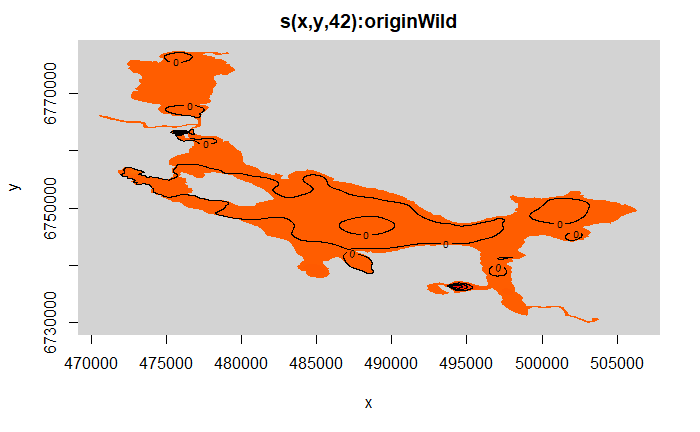I am having an issue fitting a gam with mgcv in R and am looking for some help. In brief, I have a dataset that contains numbers of fish from one of two groups (Hatchery or Wild) that were detected at receivers located in a large lake system. These receivers are placed at specific locations and have a unique longitude and latitude. The dataset was collected across 4 years. I am looking to model the number of fish detected at the receivers in each group across the study period. I have done this in R with mgcv using the following code:
mod1 <- gam(number_of_fish ~ s(x, y, by = origin, k = 40) + s(study_year, k = 3) + origin, offset = log(max_fish),
data = n_fish_spring_utm,
family=nb(link = 'log'),
method = "REML")
Here, I am using an offset for the log maximum number of fish in each group that could have been detected as the two groups had different numbers of fish. I am also using a negative binomial distribution.
This model seems to run fine.
Parametric coefficients:
Estimate Std. Error z value Pr(>|z|)
(Intercept) -2.83417 0.02592 -109.327 < 2e-16 ***
originWild 0.31964 0.04188 7.632 2.3e-14 ***
---
Signif. codes: 0 ‘***’ 0.001 ‘**’ 0.01 ‘*’ 0.05 ‘.’ 0.1 ‘ ’ 1
Approximate significance of smooth terms:
edf Ref.df Chi.sq p-value
s(x,y):originHatchery 16.393 21.146 252.9 <2e-16 ***
s(x,y):originWild 12.041 16.024 144.5 <2e-16 ***
s(study_year) 1.871 1.983 274.2 <2e-16 ***
---
Signif. codes: 0 ‘***’ 0.001 ‘**’ 0.01 ‘*’ 0.05 ‘.’ 0.1 ‘ ’ 1
R-sq.(adj) = 0.306 Deviance explained = 50.2%
-REML = 2258.5 Scale est. = 1 n = 1347
However, my lake system has lots of contours and a few large islands which I want to account for using a soap film smoother.
I generated a soap film surface using a shapefile of my lake system, and checked that it was all fine (i.e. no knots fell outside the boundry) with the soapcheckr() package.

I then ran the following model, including the soap film smoother:
mod2 <- gam(number_of_fish ~ s(x, y, by = origin, k = 40, bs = "so", xt = list(bnd = border.aut, nmax=1500)) + s(study_year, k = 3) + origin, offset=log(max_fish),
data = n_fish_spring_utm,
family=nb(link = 'log'),
method = "REML",
knots = lake_knots)
The model runs fine.
Parametric coefficients:
Estimate Std. Error z value Pr(>|z|)
(Intercept) -2.8287 4.4271 -0.639 0.523
originWild 0.2641 13.2274 0.020 0.984
Approximate significance of smooth terms:
edf Ref.df Chi.sq p-value
s(x,y):originHatchery 42.000 42.00 216.9 <2e-16 ***
s(x,y):originWild 42.000 42.00 173.2 <2e-16 ***
s(study_year) 1.827 1.97 230.4 <2e-16 ***
---
Signif. codes: 0 ‘***’ 0.001 ‘**’ 0.01 ‘*’ 0.05 ‘.’ 0.1 ‘ ’ 1
Rank: 308/866
R-sq.(adj) = 0.307 Deviance explained = 52.7%
-REML = 1640 Scale est. = 1 n = 1347
However, the plots do not seem sensible and indicate zero fish detected.


I also cannot generate plots from my model with the gratia() package as I did previously. I get the following error message:
Error in `mutate()`:ℹ In argument: `.loop = rep(seq_along(pts), each = pts)`.Caused by error:! `.loop` must be size 536 or 1, not 1446.
I have been tinkering with this for around a week and cannot seem to solve the issue. Any help or even a nudge in the right direction would be greatly appreciated!
Code, data, and the shapefile can be found here.
Thanks in advance!

